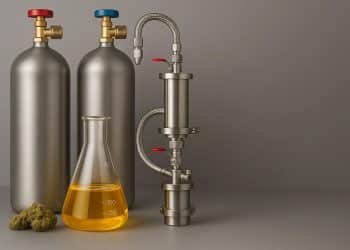When extracting botanical material, the basic steps are generally the same. [1] The plant material is gathered, a solvent is chosen, the extraction method is then implemented. When choosing a solvent, this is where the largest potential for variation occurs. Based on the type of compounds to be extracted and the extraction technique various solvents provide several advantages and disadvantages.
Ethanol is one of the most commonly used solvent for extraction of botanicals. Ethanol can be used to extract both hydrophilic and lipophilic substances. It can be used for large scale extractions, where it is possible to obtain thousands of pounds of biomass extraction per hour. [2] When compared to other solvents, ethanol is cheaper and provide high yields. One of the greatest hazards of ethanol is its high flammability.
Hexane
Hexane is typically used for oil extraction from various seeds and plant materials. Hexane is considered a valuable solvent because of its simple recovery process, its excellent solubility, and its narrow boiling point. While Hexane is widely used for botanical extraction, there are several risks involved with it. Not only it can produce harmful environmental by-products, but the EPA warns that both short and long term exposure can be harmful to humans.[3][4]
CO2
Carbon dioxide (CO2) is frequently used as solvent for thermolabile materials. Through supercritical CO2 extraction is possible to obtain clean extracts from plants with high yields in lower time compared to other extraction solvents. CO2 is non-flammable and non-toxic, ensuring a gentle treatment and easy solvent separation from the extract.
Compared to other hydrocarbon solvents CO2 requires higher pressure to reach the supercritical state thus higher equipment costs. [5]
References:
[1] Abubakar, A., & Haque, M. (2020). Preparation of medicinal plants: Basic extraction and fractionation procedures for experimental purposes. Journal of Pharmacy And Bioallied Sciences, 12(1), 1. https://doi.org/10.4103/jpbs.jpbs_175_19 [Journal impact factor = 1.26] [Times cited = 214]
[2] Kwiatkowski, J. R., & Cheryan, M. (2002). Extraction of oil from ground corn using ethanol. Journal of the American Oil Chemists’ Society, 79(8), 825–830. https://doi.org/10.1007/s11746-002-0565-8 [Journal impact factor = 1.83] [Times cited = 80]
[3]Kumar, S. P. J., Prasad, S. R., Banerjee, R., Agarwal, D. K., Kulkarni, K. S., & Ramesh, K. V. (2017). Green solvents and technologies for oil extraction from oilseeds. Chemistry Central Journal, 11(1). https://doi.org/10.1186/s13065-017-0238-8 [Journal impact factor = 4.215] [Times cited = 144]
[4]Environmental Protection Agency. (2000, January). Hexane Hazard Summary. https://www.epa.gov/sites/default/files/2016-09/documents/hexane.pdf
[5]Mendes, R. L., Nobre, B. P., Cardoso, M. T., Pereira, A. P., & Palavra, A. F. (2003). Supercritical carbon dioxide extraction of compounds with pharmaceutical importance from microalgae. Inorganica Chimica Acta, 356, 328–334. [Journal impact factor = 2.54] [Times cited = 510]
https://doi.org/10.1016/s0020-1693(03)00363-3
Image: https://www.bigstockphoto.com/it/image-1969823/stock-photo-stockpile-solvente












